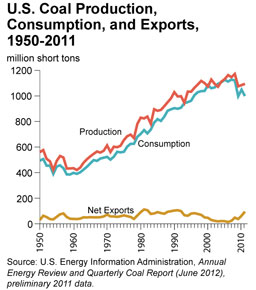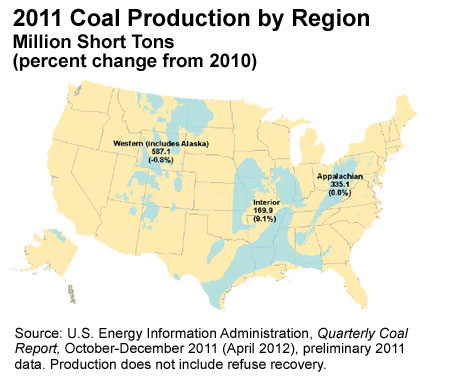What is the role of coal in the United States?The United States holds the world's largest estimated recoverable reserves of coal and is a net exporter of coal. In 2011, our nation's coal mines produced more than a billion short tons of coal, and more than 90% of this coal was used by U.S. power plants to generate electricity. While coal has been the largest source of electricity generation for over 60 years, its annual share of generation declined from 49% in 2007 to 42% in 2011 as some power producers switched to lower-priced natural gas. |
|
Did You Know?Different types of coal have different characteristics including sulfur content, mercury content, and heat energy content. Heat content is used to group coal into four distinct categories, known as ranks: anthracite, bituminous, subbituminous, and lignite (generally in decreasing order of heat content). There are far more bituminous coal mines in the United States than the other ranks (over 90% of total mines), but subbituminous mines (located predominantly in Wyoming and Montana) produce more coal because their average size is much larger. |
Did You Know?In 2011, Wyoming produced 438 million short tons of coal, or 40% of the coal mined in the United States. West Virginia was the second largest producer, with 135 million short tons (12%). Coal is an Abundant U.S. ResourceThe United States is home to the largest estimated recoverable reserves of coal in the world. In fact, we have enough coal to last more than 200 years, based on current production levels. Coal is produced in 25 states spread across three coal-producing regions. In 2011, approximately 72% of production originated in five states: Wyoming, West Virginia, Kentucky, Pennsylvania, and Texas. Most of Our Coal is Used to Generate ElectricityOver 90% of U.S. coal consumption is in the electric power sector. The United States has more than 1,400 coal-fired electricity generating units in operation at more than 600 plants across the country. Together, these power plants generate over 40% of the electricity produced in the United States and consume more than 900 million short tons of coal per year. Although coal-fired generation still holds the largest share among all sources of electricity, its use has declined since 2007 due to a combination of slow growth in electricity demand, strong price competition with natural gas, and increased use of renewable technologies. See related article — Today in Energy, July 6, 2012 While the share of our electricity generated from coal is expected to decrease by 2035, the amount of coal used to meet growing demand for power is expected to increase in the absence of new policies to limit or reduce emissions of carbon dioxide and other greenhouse gases. Revised emissions policies could significantly change the outlook for domestic coal use. See related article — Today in Energy, May 4, 2012 Besides its role in generating electricity, coal also has industrial applications in cement making and conversion to coke for the smelting of iron ore at blast furnaces to make steel. A small amount of coal is also burned to heat commercial, military, and institutional facilities, and an even smaller amount is used to heat homes. The United States Exports Coal to Other CountriesBetween 2000 and 2010, about 5% of the coal produced in the United States, on average, was exported to other countries. Coal exports come in two forms: metallurgical coal, which can be used for steel production, and steam coal, which can be used for electricity generation. In 2011, U.S. coal exports climbed to 10% (the highest level in two decades), partly because flooding disrupted coal mining in Australia, which is normally the world's largest coal exporter. Metallurgical coal dominated U.S. coal exports in 2011 with Europe the largest importer, followed by Asia. See related article — Today in Energy, June 19, 2012 The United States also imports a small amount of coal; some power plants along the Gulf Coast and the Atlantic Coast find it cheaper to import coal by sea from South America than to have it transported from domestic coal mines. Coal Is a Relatively Inexpensive FuelAlthough some natural gas plants are more efficient than coal plants at generating electricity, in the past the fuel cost of generating one kilowatthour of electricity from natural gas had typically been higher than that of coal. In 2009, coal began losing its price advantage over natural gas for electricity generation in some parts of the country, particularly in the eastern United States as a surge in natural gas production from domestic shale deposits (made possible by advances in drilling technologies) substantially reduced the price of natural gas. See related article — Today in Energy, July 13, 2012 Environmental Effects from Using CoalCoal is plentiful and fairly cheap relative to the cost of other sources of electricity, but its use produces several types of emissions that adversely affect the environment. Coal emits sulfur dioxide, nitrogen oxide, and heavy metals (such as mercury and arsenic) and acid gases (such as hydrogen chloride), which have been linked to acid rain, smog, and health issues. Coal also emits carbon dioxide, a greenhouse gas. In 2011, coal accounted for 34% of the energy-related carbon dioxide emissions in the United States. On the production-side, coal mining can have a negative impact on ecosystems and water quality, and alter landscapes and scenic views. Outlook for Future Coal UseThe economics of burning coal may change if the U.S. adopts policies that restrict or otherwise control carbon dioxide emissions. For example, a cap-and-trade program to regulate carbon dioxide emissions would likely increase the cost of burning coal because of its carbon content, and thereby cause power companies to consider using less carbon-intensive generating technologies such as nuclear, renewables, and natural gas. In March 2012, the U.S. Environmental Protection Agency proposed a new source performance standard for emissions of carbon dioxide (CO2) that would establish an output-based emission limit of 1,000 pounds of CO2 per megawatthour for new fossil-fuel-fired power plants. This emission limit would effectively require that new coal-fired generating units employ carbon capture and sequestration (CCS) technologies to reduce uncontrolled emissions of CO2 by approximately 50%. Researchers are working on ways to lower the costs and improve the efficiency of various CCS technologies with a goal of capturing approximately 90% of the carbon dioxide from coal plants before it is emitted into the atmosphere and then storing it below the Earth's surface. CCS would theoretically address much of coal's carbon dioxide emissions; however, substantial economic and technological hurdles remain. |

For larger graphs and maps, and other Energy in Briefs, please visit www.eia.gov/eib.



